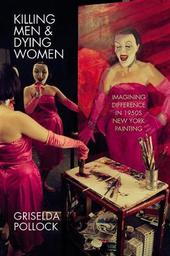
|
Killing Men & Dying Women: Imagining Difference in 1950s New York Painting
Paperback / softback
Main Details
Description
What did it mean for painter Lee Krasner to be an artist and a woman if, in the culture of 1950s New York, to be an artist was to be Jackson Pollock and to be a woman was to be Marilyn Monroe? With this question, Griselda Pollock begins a transdisciplinary journey across the gendered aesthetics and the politics of difference in New York abstract, gestural painting. Revisiting recent exhibitions of Abstract Expressionism that either marginalised the artist-women in the movement or focused solely on the excluded women, as well as exhibitions of women in abstraction, Pollock reveals how theories of embodiment, the gesture, hysteria and subjectivity can deepen our understanding of this moment in the history of painting co-created by women and men. Providing close readings of key paintings by Lee Krasner and re-thinking her own historic examination of images of Jackson Pollock and Helen Frankenthaler at work, Pollock builds a cultural bridge between the New York artist-women and their other, Marilyn Monroe, a creative actor whose physically anguished but sexually appropriated star body is presented as pathos formula of life energy. Monroe emerges as a haunting presence within this moment of New York modernism, eroding the policed boundaries between high and popular culture and explaining what we gain by re-thinking art with the richness of feminist thought.
Author Biography
Griselda Pollock is Professor of Social and Critical Histories of Art at the University of Leeds -- .
Reviews'With theoretic acuity, Griselda Pollock revisits New York Abstract Expressionism to propose a feminist reading of the Jewish-American artist Lee Krasner that is as astonishing as it is compelling. Seeking to discover inscriptions of feminine sexual difference, these psychoanalytically inspired essays revolve around a conceptual triangulation, in which Krasner's position as a painter-woman in abstract art is conceived as a third position, interrogating and reworking two competing components of her creative energy - with Jackson Pollock as an iconisation of her identity as an artist and Marilyn Monroe as an iconisation of her identity as a woman. The triptych that emerges is utterly riveting.' Elisabeth Bronfen, Professor of English and American Studies, University of Zurich 'Killing Men & Dying Women represents an exciting new development for Griselda Pollock's work. She deconstructs the misogyny of 1950s America as well as an art establishment that critically ignored and institutionally marginalised the women artists of Abstract Expressionism. Making an unflinching use of feminist psychoanalytic theory, she argues for a more significant maternal relation in the human psyche's development than traditional psychoanalysis allows. This perspective brings into visibility occluded modes of feeling and understanding that women's art, fragilely, preserves. The image and the story of Marilyn Monroe is woven into the texture of the argument, upsetting the decade's transcendent image of "woman" and revealing the patriarchal insecurities it represented.' Laura Mulvey, Professor of Film Studies, Birkbeck, University of London 'A book that reveals art history as a concerted and difficult and passionate business - a contest, a battle, in short, a lived experience.' Alexander Nemerov, Carl and Marilynn Thoma Provostial Professor in the Arts and Humanities, Stanford University -- .
|